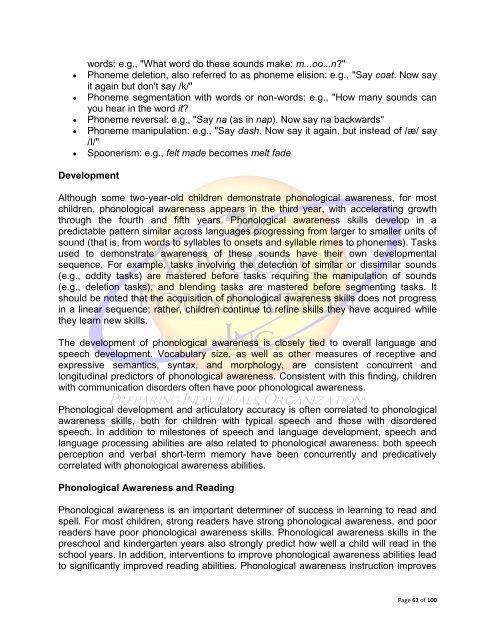Overcoming Dyslexia
Overcoming Dyslexia
Overcoming Dyslexia
Create successful ePaper yourself
Turn your PDF publications into a flip-book with our unique Google optimized e-Paper software.
words: e.g., "What word do these sounds make: m...oo...n?"<br />
Phoneme deletion, also referred to as phoneme elision: e.g., "Say coat. Now say<br />
it again but don't say /k/"<br />
Phoneme segmentation with words or non-words: e.g., "How many sounds can<br />
you hear in the word it?<br />
Phoneme reversal: e.g., "Say na (as in nap). Now say na backwards"<br />
Phoneme manipulation: e.g., "Say dash. Now say it again, but instead of /æ/ say<br />
/I/"<br />
Spoonerism: e.g., felt made becomes melt fade<br />
Development<br />
Although some two-year-old children demonstrate phonological awareness, for most<br />
children, phonological awareness appears in the third year, with accelerating growth<br />
through the fourth and fifth years. Phonological awareness skills develop in a<br />
predictable pattern similar across languages progressing from larger to smaller units of<br />
sound (that is, from words to syllables to onsets and syllable rimes to phonemes). Tasks<br />
used to demonstrate awareness of these sounds have their own developmental<br />
sequence. For example, tasks involving the detection of similar or dissimilar sounds<br />
(e.g., oddity tasks) are mastered before tasks requiring the manipulation of sounds<br />
(e.g., deletion tasks), and blending tasks are mastered before segmenting tasks. It<br />
should be noted that the acquisition of phonological awareness skills does not progress<br />
in a linear sequence; rather, children continue to refine skills they have acquired while<br />
they learn new skills.<br />
The development of phonological awareness is closely tied to overall language and<br />
speech development. Vocabulary size, as well as other measures of receptive and<br />
expressive semantics, syntax, and morphology, are consistent concurrent and<br />
longitudinal predictors of phonological awareness. Consistent with this finding, children<br />
with communication disorders often have poor phonological awareness.<br />
Phonological development and articulatory accuracy is often correlated to phonological<br />
awareness skills, both for children with typical speech and those with disordered<br />
speech. In addition to milestones of speech and language development, speech and<br />
language processing abilities are also related to phonological awareness: both speech<br />
perception and verbal short-term memory have been concurrently and predicatively<br />
correlated with phonological awareness abilities.<br />
Phonological Awareness and Reading<br />
Phonological awareness is an important determiner of success in learning to read and<br />
spell. For most children, strong readers have strong phonological awareness, and poor<br />
readers have poor phonological awareness skills. Phonological awareness skills in the<br />
preschool and kindergarten years also strongly predict how well a child will read in the<br />
school years. In addition, interventions to improve phonological awareness abilities lead<br />
to significantly improved reading abilities. Phonological awareness instruction improves<br />
Page 62 of 100

















